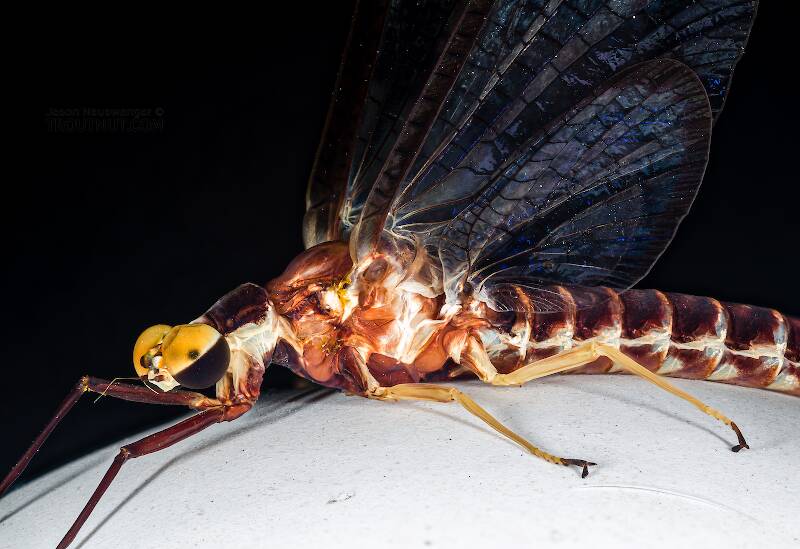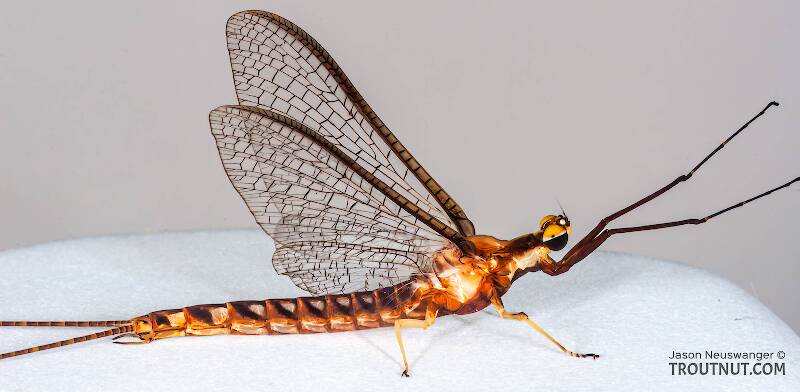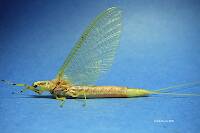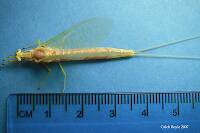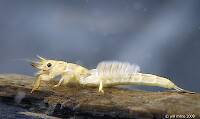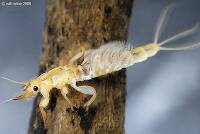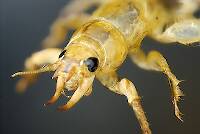
Salmonflies
Pteronarcys californica
The giant Salmonflies of the Western mountains are legendary for their proclivity to elicit consistent dry-fly action and ferocious strikes.
Featured on the forum

Some characteristics from the microscope images for the tentative species id: The postero-lateral projections are found only on segment 9, not segment 8. Based on the key in Jacobus et al. (2014), it appears to key to Neoleptophlebia adoptiva or Neoleptophlebia heteronea, same as this specimen with pretty different abdominal markings. However, distinguishing between those calls for comparing the lengths of the second and third segment of the labial palp, and this one (like the other one) only seems to have two segments. So I'm stuck on them both. It's likely that the fact that they're immature nymphs stymies identification in some important way.

Troutnut is a project started in 2003 by salmonid ecologist Jason "Troutnut" Neuswanger to help anglers and
fly tyers unabashedly embrace the entomological side of the sport. Learn more about Troutnut or
support the project for an enhanced experience here.
This topic is about the Mayfly Species Hexagenia limbata
It starts like a rise of small trout. There are dimples on the surface--fingerling trout eating midges, perhaps. But these are no fish. The water breaks and out pop the yellow sails of a giant Hexagenia dun. Then another. And another. A vortex appears in a flash below the mayfly and it vanishes with a slurp so loud it echoes off the distant bank. A square tail like a shark fin breaks the surface behind the swirl as a brown trout twice the size of your net retreats back to his deeper lair. The Hex hatch is on.This Midwestern legend plays out every year on calm, dark, humid nights in early July. Anglers who only fly fish once a year drive hundreds of miles to play their part in the drama, while the mayflies themselves make the television news by showing up on doppler radar or calling snowplows out of dormancy to remove layers of Hexagenia (or "Hex") duns from the bridges. In the cold trout rivers of Wisconsin and Michigan, huge nocturnal brown trout whose usual menu consists of smaller brown trout become, for a week or so, prime dry fly quarry.
According to the literature, these are the second largest mayflies in the United States, behind the related Litobrancha recurvata flies. However, there are reports of limbata exceeding 40mm in some locales, which would make them the largest.
Example specimens
Millerpa on Jun 18, 2006June 18th, 2006, 3:02 pm EDT
I have read in many places that the Hex nymph is a mud dweller. What does this mean? Does this mean they immediately change from egg to nymph and then burrow into the mud until emergence or do they simply burrow in the mud to find food and spend some time in the open water between meals? I have heard comments from fisherman that indicate they know the hatch has been happening when they see small holes in the muddy banks of the river. This is abit confusing to me. Could someone please clarify.
Troutnut on Jun 18, 2006June 18th, 2006, 4:30 pm EDT
or do they simply burrow in the mud to find food and spend some time in the open water between meals?
Close... it's actually kind of the opposite. Hex nymphs are nocturnal (as you might guess from their pale, light-sensitive bodies). They live in their burrows during the day and come out at night to forage around the stream bottom for food, by some reports. Others report that they only come out to molt, approximately once every 24 days, but when there are so many nymphs in the stream even this can make for good numbers.
You can see the little holes in the mud at any time of year, but there is a common belief (and my very limited observations confirm it, for what they're worth) that those holes are much more noticeable around emergence time. I'm not sure how to reconcile this with what I've read about their nighttime behavior.
So I guess I can't give you a perfect answer. But I can tell you for sure that they spend plenty of time outside of their burrows as nymphs.
Jason Neuswanger, Ph.D.
Troutnut and salmonid ecologist
Troutnut and salmonid ecologist
Millerpa on Jun 19, 2006June 19th, 2006, 11:21 am EDT
Thanks for info. Off to the steam. Hex is on!
Taxon on Jun 26, 2006June 26th, 2006, 10:06 am EDT
Millerpa-
Couple things I'll add to Jason's great answer: Their burrow is a U-shaped tunnel; they are generally semi-voltine, meaning there is a new generation every two years, and of course, they are largest just prior to emergence, so would need the largest tunnel openings at that time.
Couple things I'll add to Jason's great answer: Their burrow is a U-shaped tunnel; they are generally semi-voltine, meaning there is a new generation every two years, and of course, they are largest just prior to emergence, so would need the largest tunnel openings at that time.
Beardius
Posts: 19
Posts: 19
Beardius on Aug 1, 2008August 1st, 2008, 7:38 am EDT
I cannot speak for Hexagenia because I have not worked with them much. However, Ephemera and Litobrancha nymphs stay within their burrows almost all the time. I used to rear these nymphs by the hundreds within plastic cups placed in streams, and then check them every 3 hours for 24-48 hours to obtain data on their emergence as well as that of midges associated with them. I don't recall ever observing nymphs out of their burrows at night. I would be very surprised if Hexagenia behaved differently. It wouldn't make much sense for them to do so because they would be very vulnerable to predation. But again, I haven't reared Hexagenia much.
Grannom on Aug 1, 2008August 1st, 2008, 2:29 pm EDT
This dude came outta nowhere and he's kickin ass on every thread! BAM! POW! KA-CHOW!
"Be calm - you're there..." "...Tell yourself there's no rush, even if there is."
-John Gierach
-John Gierach
Beardius
Posts: 19
Posts: 19
Beardius on Aug 8, 2008August 8th, 2008, 6:32 am EDT
Grannom,
Thanks for the reply (I think). I worked on midges associated with burrowing mayflies in MD and PA for my PhD dissertation. This involved rearing hundreds of burrowing mayflies with associated midges and recording when the midges and mayflies emerged. I tried to obtain data on diel emergence patterns by checking for emerged midges and mayflies at 3 hour intervals around the clock. This required checking rearing cups at night with a flashlight covered with red plastic. I just don't recall seeing the nymphs out of their burrows that often, if at all. That may not be the case with Hexagenia, though.
Thanks for the reply (I think). I worked on midges associated with burrowing mayflies in MD and PA for my PhD dissertation. This involved rearing hundreds of burrowing mayflies with associated midges and recording when the midges and mayflies emerged. I tried to obtain data on diel emergence patterns by checking for emerged midges and mayflies at 3 hour intervals around the clock. This required checking rearing cups at night with a flashlight covered with red plastic. I just don't recall seeing the nymphs out of their burrows that often, if at all. That may not be the case with Hexagenia, though.
Martinlf on Aug 8, 2008August 8th, 2008, 1:13 pm EDT
And I thought the work I did on my dissertation was a pain.
"He spread them a yard and a half. 'And every one that got away is this big.'"
--Fred Chappell
--Fred Chappell
Beardius
Posts: 19
Posts: 19
Beardius on Dec 4, 2008December 4th, 2008, 7:32 pm EST
Though my research was, at times, very tiring, it was a labor of love. I really enjoyed working on larger aquatic insects and the midges that make a living associated with them. Watching Pteronarcys emerge at night is really neat to watch. It takes them 10-15 seconds to eclose, so they have to do this in the dark to avoid predation.
Beardius
Posts: 19
Posts: 19
Beardius on Dec 4, 2008December 4th, 2008, 8:01 pm EST
A reply for Taxon:
Yes, I believe Hexagenia are semi-voltine. Of course, it depends upon where they live. In cold climates, they may have 2 year (semi-voltine) or even 3 year life cycles. In warmer climates, they may be able to complete a generation in a year. The Ephemera and Litobrancha I worked on generally had a 2-year life cycle, though there may be some cohort splitting going on whereby a few individuals may be delayed an extra year and emerge with a different cohort a year late. Generally, Pennsylvania streams have two cohorts of semi-voltine nymphs, each of which emerge in even and odd numbered years. My hunch is that genetic comparisons between cohorts would show that they are virtually identical, suggesting that there are some nymphs every year that take either one or three years to complete their life cycle and contribute their genetics to the other cohort.
Ephemera guttulata nymphs can attain pretty decent size (15 mm) after one year if they find ideal habitat (mixed fines) for their growth. On the other hand, Litobrancha nymphs usually are small after one year, but show tremendous growth in their second year. I suspect it is because it probably takes them awhile to find the ideal habitat (fine muck along stream edges) for them to put on size. The effect of habitat and food quality on growth rates has never been looked at in these species (Ephemera spp. and Litobrancha recurvata). Some work has been done on Hexagenia by students of Jan Ciborowski in Canada. Much of what is published on these taxa was done by Caucci and Nastasi and other fly fishermen/authors.
Lots of stuff here to research further. These critters are very easy to rear, particularly Litobrancha which is very hardy and resistant to handling.
Yes, I believe Hexagenia are semi-voltine. Of course, it depends upon where they live. In cold climates, they may have 2 year (semi-voltine) or even 3 year life cycles. In warmer climates, they may be able to complete a generation in a year. The Ephemera and Litobrancha I worked on generally had a 2-year life cycle, though there may be some cohort splitting going on whereby a few individuals may be delayed an extra year and emerge with a different cohort a year late. Generally, Pennsylvania streams have two cohorts of semi-voltine nymphs, each of which emerge in even and odd numbered years. My hunch is that genetic comparisons between cohorts would show that they are virtually identical, suggesting that there are some nymphs every year that take either one or three years to complete their life cycle and contribute their genetics to the other cohort.
Ephemera guttulata nymphs can attain pretty decent size (15 mm) after one year if they find ideal habitat (mixed fines) for their growth. On the other hand, Litobrancha nymphs usually are small after one year, but show tremendous growth in their second year. I suspect it is because it probably takes them awhile to find the ideal habitat (fine muck along stream edges) for them to put on size. The effect of habitat and food quality on growth rates has never been looked at in these species (Ephemera spp. and Litobrancha recurvata). Some work has been done on Hexagenia by students of Jan Ciborowski in Canada. Much of what is published on these taxa was done by Caucci and Nastasi and other fly fishermen/authors.
Lots of stuff here to research further. These critters are very easy to rear, particularly Litobrancha which is very hardy and resistant to handling.
Quick Reply
Related Discussions
Topic
Replies
Last Reply
1
Aug 1, 2008
by Troutnut
by Troutnut
I agree with the nymph and emergence coments above
In the Mayfly Species Litobrancha recurvata by Beardius
In the Mayfly Species Litobrancha recurvata by Beardius
0
Aug 1, 2008
by Beardius
by Beardius
1
May 5, 2009
by GONZO
by GONZO
4
May 19, 2009
by Willmilne
by Willmilne
0
Aug 12, 2012
by Hdhungryman
by Hdhungryman



